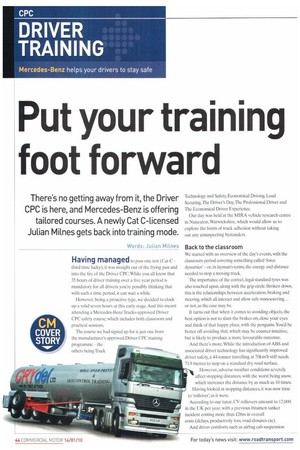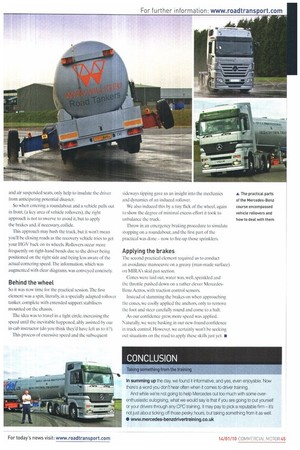Put your training foot forward
Page 44

Page 45

If you've noticed an error in this article please click here to report it so we can fix it.
There's no getting away from it, the Driver CPC is here, and Mercedes-Benz is offering tailored courses. A newly Cat C-licensed Julian Milnes gets back into training mode.
Words; Jutian Manes
Having managed to pass one test (Cat C — third time lucky), it was straight out of the frying pan and into the fire of the Driver CPC. While you all know that 35 hours of driver training over a five-year period is mandatory for all drivers, you're possibly thinking that with such a time period, it can wait a while.
However, being a proactive type, we decided to clock up a solid seven hours at this early stage. And this meant attending a Mercedes-Benz Trucks-approved Driver CPC safety course, which includes both classroom and practical sessions.
The course we had signed up for is just one from the manufacturer's approved Driver CPC training programme — the others being Truck Technology and Safety, Economical Driving, Load Securing, The Driver's Day,The Professional Driver and The Economical Driver Experience.
Our day was held at the MIRA vehicle research centre in Nuneaton, Warwickshire, which would allow us to explore the limits of truck adhesion without taking out any unsuspecting bystanders.
Back to the cLassroom We started with an overview of the day's events, with the classroom period covering something called 'force dynamics' — or, in layman's terms, the energy and distance needed to stop a moving truck.
The importance of the correct, legal standard tyres was also touched upon, along with the grip circle. Broken down, this is the relationships between acceleration, braking and steering, which all interact and allow safe manoeuvring... or not, as the case may he.
It turns out that when it comes to avoiding objects, the best option is not to slam the brakes on, close your eyes and think of that happy place, with the penguins. You'd be better off avoiding that, which may be counter-intuitive, but is likely to produce a more favourable outcome.
And there's more. While the introduction of ABS and associated driver technology has significantly improved driver safety, a 44-tonner travelling at 70km/h still needs 71.9 metres to stop on a standard dry road surface.
However, adverse weather conditions severely affect stopping distances, with the worst being snow, which increases the distance by as much as 10 times.
Having looked at stopping distances, it was now time to 'rollover', as it were.
According to our tutor, CV rollovers amount to 12,000 in the UK per year, with a previous bitumen tanker incident costing more than £26m in overall costs (delays, productivity loss, road closures etc). And driver comforts, such as airbag cab suspension and air suspended seats, only help to insulate the driver from anticipating potential disaster.
So when entering a roundabout and a vehicle pulls out in front, (a key area of vehicle rollovers), the right approach is not to swerve to avoid it, but to apply the brakes and, if necessary, collide.
This approach may bash the truck, but it won't mean you'll be closing roads as the recovery vehicle tries to get your HGV back on its wheels. Rollovers occur more frequently on right-hand bends due to the driver being positioned on the right side and being less aware of the actual cornering speed. The information, which was augmented with clear diagrams, was conveyed concisely.
Behind the wheel
So it was now time for the practical session. The first element was a spin, literally, in a specially adapted rollover tanker, complete with extended support stabilisers mounted on the chassis.
The idea was to travel in a tight circle, increasing the speed until the inevitable happened, ably assisted by our in-cab instructor (do you think they'd have left us to it?).
This process of excessive speed and the subsequent sideways tipping gave us an insight into the mechanics and dynamics of an induced rollover.
We also induced this by a tiny flick of the wheel, again to show the degree of minimal excess effort it took to unbalance the truck.
Throw in an emergency braking procedure to simulate stopping on a roundabout, and the first part of the practical was done — now to fire-up those sprinklers.
Applying the brakes
The second practical element required us to conduct an avoidance manoeuvre on a greasy (man-made surface) on MIRA's skid pan section.
Cones were laid out, water was, well, sprinkled and the throttle pushed down on a rather clever MercedesBenz Actros, with traction control sensors.
Instead of slamming the brakes on when approaching the cones, we coolly applied the anchors, only to remove the foot and steer carefully round and come to a halt.
As our confidence grew, more speed was applied. Naturally, we were basking in our new-found confidence in truck control. However, we certainly won't be seeking out situations on the road to apply these skills just yet. •




































































































































